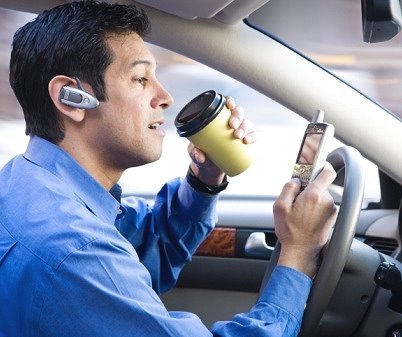

Texting, changing the radio station, putting on makeup are all fairly simple tasks. When practiced behind the wheel, they become far more complicated and worse they become far more dangerous.
Distracted driving claimed the lives of over 3,000 people in 2011 and, sadly, a figure like this one won’t simply disappear. The National Highway Traffic Safety Administration (NHTSA) even created a new form of measurement for fatalities resulting from distracted driving, known as “distraction-affected crashes.”
So, how can we get that number down to zero? Awareness plays a big role in accident prevention and with that in mind, read on to find out more about distracted driving behaviors and how you can correct them.
There are three types of distraction: visual, cognitive, and manual. Visual distraction is when your eyes are focused on something other than the road or your driving; cognitive distraction is where a driver’s mind is elsewhere while behind the wheel (engaged in conversation with a passenger, daydreaming, etc.); and manual distraction occurs when a driver takes one or both hands off the steering wheel.
There are many actions that fit these individual descriptions when driving, but the most dangerous ones, like texting, involve all three.
We live in a multitasking society and for the busy American using a cell phone while driving just makes sense. But, texting from the driver’s seat is one of the riskiest distracted driving practices.
According to the NHTSA, 21 percent of all 15- to 19-year-old distracted drivers involved in fatal accidents were distracted by cell phone use. It can be tempting to reach over and pick up that phone when it rings or buzzes. However, you are protecting your life and the lives of other road users when you avoid this kind of behavior.
How to Avoid It:
Listening to music while driving is a given for most people. The good thing about it is that it is one of the easier distractions to control. However, it is still one of the most common ways that drivers lose their focus. In fact, according to a report from the University of North Carolina Highway Safety Research Center, adjusting audio controls was the second-highest specific source of distraction for drivers (11.6 percent) in an analysis of national crash data.
How to Avoid It:
For a lot of drivers, this may not register as a distraction, but even the simple act of talking to others in the same vehicle takes your focus off the road. This is an even bigger issue for newly licensed teen drivers who are relatively inexperienced, and therefore not as talented at multitasking behind the wheel as their parents might be.
Not to mention the peer pressure that teens place on their friends: a study conducted by the Children’s Hospital of Philadelphia and State Farm, which analyzed 677 teens who had been involved in serious car crashes, found that male teens driving passengers were six times more likely to carry out an illegal driving maneuver, and more than twice as likely to drive aggressively right before an accident, as do males driving alone.
To combat this negative influence, 47 states, as well as Washington, D.C., have implemented Graduated Driver Licensing (GDL) laws with restrictions on the number of passengers that new drivers may have. Even after these restrictions are lifted, passengers can cause difficulties for drivers.
How to Avoid It:
Distractions aren’t always avoidable, but they can be managed. And when it comes to driving, where lives are at risk, this becomes an especially important task. So keep your eyes on the road and don’t give in to those distractions!
